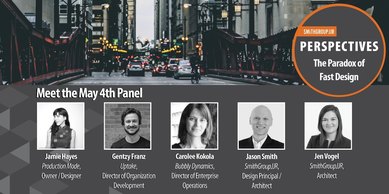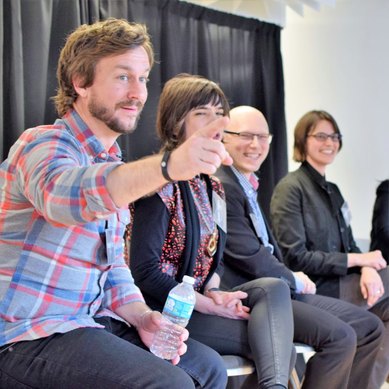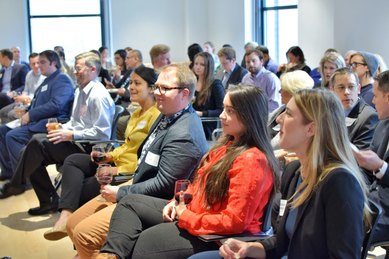Fast Design
Speed to market and the need for fast growth is paramount for most businesses today, from start-ups to large corporations. It is the decisive competitive advantage in today’s marketplace to decide fast, ideate fast, change fast, and fail fast. The impact of speed challenges designers to find solutions that balance fast growth with sustainable choices, while creating resiliency in the built environment.
To examine this paradox of speed and sustained growth, the discussion at SmithGroupJJR’s most recent Perspectives panel brought a diverse group of thought leaders from seemingly disparate industries. Moderated by Jen Vogel, of the SmithGroupJJR Chicago office, the conversation included:
The conversation centered on how hyperlocalization has impacted the design community and its effects on the City of Chicago and surrounding communities, institutions, and buildings. However, it immediately became apparent that the varying factors of speed played heavily into each panelists own approach to their craft.
Jamie, as a sole proprietor and “slow fashion” entrepreneur, noted the impact that speed has had on “fast fashion” and the global environment and sustainability. She perceives many aspects of her industry at large, one that produces nearly 26 billion pounds of waste annually and exploits low wage labor in developing countries, as a race to the bottom. The constant changing of seasonal collections—as many as 26 collections per year with some brands—has produced a disposable fashion economy. The effect has turned the apparel industry from creating durable products we use, like a refrigerator, into creating disposable products we use up, like a cigarette.
In contrast, Gentzy viewed speed as an essential ingredient to the growth and survival of Uptake, which hires an astounding 20 new employees every two weeks and has soared from three to 700 employees in only three years. Competing with global giants like GE Digital and with the constant threat from new startup players, the speed for growth is necessary to maintain their share of the market. However, this speed is not without an inherent contradiction. In order to provide their clients with the best predictive analytics, Gentzy noted that there is a need to study as large a data set as possible, which takes time to compile to deliver the best results.
It is this balance of tempo that also defines the work Carolee seeks in her work at The Plant, an incubator for small, sustainable food production businesses. At first there was an initial need to open fast to capture their original group of core tenants to reach a profitable business model. This original core group only occupied a small portion of space of The Plant, which anticipated steadily adding businesses to produce a sustained growth. This was an intentional and deliberate design parameter that allowed them to course-correct over time and adapt the changing needs of the startups that lease their space. As The Plant has continued to slowly evolve over the past three years, it’s created a vibrant hyperlocal business community supplying products from produce to bread, coffee to beer, with the ability to harness a strong local market while also capitalizing on the connection to a global market that Chicago can provide.
The benefits of this hyperlocal market were echoed by Jamie, whose client base comes from all over the globe, but utilizes distinctly local Chicago sources. Similarly, Getzy is funneling new talent from organizations like Blue|1647, a startup and business incubator that focuses on connecting and building up the talent of the Pilsen community to expand opportunity to underserved tech students and entrepreneurs.
It’s the locally-sourced pedigree and these businesses’ return to craft, Jason noted, that is the interweaving thread that ties these seeming disparate group of panelists together as designers. Jason noted that technology is always advancing in the architecture industry, and SmithGroupJJR has been in the forefront of utilizing technology to design solutions for clients faster. However, “the challenge for us as designers is to use our craft to design something better.” Taking the time to understand and specifically tailor and test design solutions, regardless of how any one industry has sped up, is still important to the design of a building, a phone app, an apparel piece, or growing produce.
Design trends may produce a subdivision of “McMansions,” or bi-weekly “seasonal” collections from H&M, but understanding these trends is an important aspect to the craft of design. As Jason pointed out, “trendy things done well become timeless,” and it is the focus on the craft of design that separates good design from bad. It is this return to craft that separates a higher priced couture garment from a fast-fashion one, the desire to buy more expensive locally-grown organic produce, or the enjoyment of a craft beer over a mass-produced beer.
While the role of the artist is to produce a one-off item during a creative phase, the role of the designer is to strike a balance between methodical, practical, and tactical mindsets—a true right and left brain approach. Jamie said it best, “a designer has both sides of the brain firing at the same time. A designer is someone who has to solve problems, exist in the [global] market, and put things into production.”
This brings on the decision as designers to choose to align our own values and those of our clients so the design process has a collaborative execution. In the case of SmithGroupJJR, this may mean being more selective with the projects we work on. In the case of Uptake, this may mean not telling an employee they are not working out, but that they are not the right fit. Or in the case of Production Mode, choosing a client base to their specific portion of the market, which is small but impactful to their product line.
This is not a negative impact, but rather the focused solution that is the product of localized design.
We will continue to explore how hyperlocalization has impacted the design community in a global marketplace in our second event in this series. We hope you can join us for the conversation in August for Mapping the Urban Genome: A Story of Evolving & Adapting Communities to examine the changing role and identity of our communities, design drivers, and enablers, and how an urban ecosystem regenerates for resiliency.


